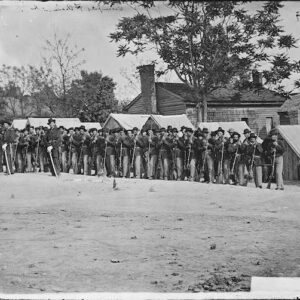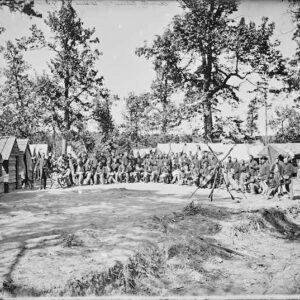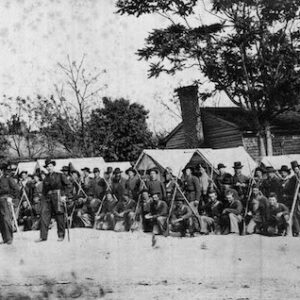Tag: 9th Indiana Infantry
Wikipedia says: The 9th Indiana Volunteer Infantry Regiment was a volunteer infantry regiment in the Union Army during the American Civil War. It was organized on April 22, 1861, for three-months’ service in Indianapolis. After being reorganized for three years’ service in late August and early September 1861, the 9th took part in many major battles, including Shiloh, Stones River, Chickamauga, Lookout Mountain, Missionary Ridge, Kennesaw Mountain and the Siege of Atlanta.
The 9th was mustered out on September 28, 1865, after duty at San Antonio and New Braunfels, Texas.
Personnel
Governor Oliver Hazard Perry Morton appointed Robert H. Milroy as colonel of the 9th on April 26, 1861, nearly two weeks after the firing began at the Battle of Fort Sumter.
By September 3, 1861, Milroy had become a brigadier general. He continued to command troops in West Virginia (as Commander of the Cheat Mountain District) into 1862.
By the time the 9th was assigned to William B. Hazen’s 19th Brigade of Buell’s Army of the Ohio in March 1862, Colonel Gideon C. Moody, a former prosecutor and politician, commanded the regiment. Hazen called Moody “a most gallant officer.”
Isaac C.B. Suman, initially the captain of Company H, then became colonel of the 9th. He commanded the 9th during such major battles as Chickamauga.
William H. Blake, initially a major, later became colonel of the 9th. Dudley H. Chase served as a captain in Company K of the 9th in the three-month regiment. William P. Lasselle began as a sergeant in Company K in the three-month regiment and finished as a lieutenant colonel in the three-year regiment. James Nutt of Company I began as a first sergeant and ended as a captain of the three-year regiment. Photographs of some of these officers and a number of other officers and enlisted men from the 9th can be found at Indiana Civil War Soldiers, 9th Infantry.
Engagements
Soldiers from the 9th Indiana Infantry were among the first troops of Major General George B. McClellan’s Department of the Ohio to enter western Virginia in the spring of 1861. As the first Indiana regiment to depart, the 9th was reviewed by Governor Morton and General McClellan, then departed for Grafton, Virginia (now Grafton, West Virginia) via railroad at midnight on May 29, 1861. Crowds in central Ohio cheered for the troops as the train passed.
Battle of Philippi
June 3, 1861. After some skirmishes at Grafton, one of the first land battles of the Civil War, the Battle of Philippi, took place in Philippi, Barbour County, in what is now West Virginia. The battle began when a Federal battery started lobbing shells into a camp of around 825 and surprised Confederate recruits who had been asleep. In response, the Confederates ran, thus earning the battle the name “Philippi Races.” After the battle, the 9th camped on the same hill where the battery was located.
Ambrose Bierce mentioned being at Philippi Races. He had enlisted as a private in Company C. Years later, in 1903, Bierce revisited the town. He recalled that visit and the battle in a 1904 piece written for the Eighth Annual Reunion of the 9th Indiana, noting that the Union battery involved “did nothing worse than take off a young Confederate’s leg.”
Battle of Laurel Mountain
July 7–11, 1861. The Battle of Laurel Mountain, also known as Laurel Hill, pitted 3,500 forces under Union Brigadier General Thomas A. Morris against what Morris perceived to be superior forces of 4,000 under Confederate Brigadier General Robert S. Garnett. McClellan had ordered Morris to occupy Garnett while McClellan’s own force of 5,000 attacked 1,300 men under Lt. Col. John Pegram at Rich Mountain.
As part of Morris’ brigade, the 9th Indiana, taking cover behind trees, exchanged fire with Confederates, who were behind breastworks. Tiring of the stalemate that ensued, the Union troops charged the breastworks and did “well enough, considering the hopeless folly of the movement,” according to Ambrose Bierce. After Corporal Dyson Boothroyd of the 9th’s Company A was wounded in the neck and paralyzed during the charge, Bierce carried Boothroyd “fully 20 rods” (100 m) under enemy fire to safety, only to see him die later, according to an Indianapolis Journal reporter’s account. Garnett and his forces retreated to the Cheat River, 10 miles to the northeast. The 9th along with the rest of Morris’ brigade (including the Seventh Indiana and the 14th Ohio) pursued Garnett to Corrick’s Ford.
Battle of Corrick’s Ford
July 12–14, 1861. Heavy rains complicated Garnett’s retreat, resulting in a wagon train becoming mired in the mud at Corrick’s Ford, located east of Philippi near St. George (now St. George, West Virginia). By July 13, 1861, the bulk of Garnett’s troops had moved north of Job’s Ford, near Parsons on the Cheat River. During their retreat, they had crossed the river numerous times to evade the Union forces. To ensure the escape of most of his forces, Garnett ordered the 23rd Virginia Infantry to make a stand in a laurel thicket on the east side of Shaver’s Fork at Corrick’s Ford. He stayed with this regiment and used the wagon train in the mud as a decoy. This planned ambush ultimately failed. Morris’ brigade successfully attacked and displaced the 23rd, and a member of the Seventh Indiana managed to shoot Garnett in the spine, killing him.
Battle of Cheat Mountain
September 12–16, 1861. Morris asserts that the 9th was in Elkwater on September 12 and was not engaged during Lee’s attack, but another source states that a column of Lee’s attacked Elkwater on or about September 12, and that the Unionists drove them off with no difficulty. Bierce didn’t mention this attack in any of his surviving writings.
Battle of Greenbrier River
October 3–4, 1861. Bierce did mention the fighting at Greenbrier River, which he called a “reconnaissance in force.” A Union force of 5,000 under Joseph J. Reynolds exchanged artillery fire with a Confederate force of 2,000 under H.R. Jackson remaining at Camp Bartow to guard the Staunton-Parkersburg Pike. The Confederates succeeded in defending the road because their artillery was well placed, protected and effective. During a 1903 visit to the site, Bierce noted Union graves, most of which had been opened, with the bodies relocated to the National Cemetery at Grafton. He observed that some graves had been apparently overlooked. There were also between 80 and 100 graves behind the Confederate earthworks that were neglected.
One of the bodies initially buried at Greenbrier River was that of J.A. Abbott of Bierce’s company. After a 1909 visit to the area, Bierce recounted the manner of Abbott’s death, although he did not personally witness it: “He was lying flat upon his stomach and was killed by being struck in the side by a nearly spent cannon-shot that came rolling in among us. The shot remained in him until removed. It was a solid round-shot, apparently cast in some private foundry, whose proprietor, setting the laws of thrift above those of ballistics, had put his ‘imprint’ upon it; upon it: it bore, in slightly sunken letters, the name ‘Abbott.'”
Battle of Camp Allegheny
December 13, 1861. The 9th formed part of a brigade under their old regimental commander, now Brigadier General Robert H. Milroy, that attacked Col. Edward Johnson’s forces protecting the Staunton-Parkersburg Pike. They exchanged fire for a good portion of that morning, and the Confederates managed to force a Union retreat back to the Cheat Mountain camps.
The 9th participated in building the Union fortification at the summit of Cheat Mountain during the winter of 1861, according to Bierce, who said the following about this after a visit in 1909: “Here we slew the forest and builded us giant habitations (astride the road from Nowhere to the southeast) commodious to lodge and army and fitly loopholed for discomfiture of the adversary. The long logs that it was our pride to cut and carry! The accuracy with which we laid them one upon another, hewn to the line and bulletproof. The Cyclopean doors that we hung, with sliding blots fit to be the ‘mast of some great admiral!’ And when we had ‘made the pile complete’ some marplot of the Regular Army came that way and chatted a few moments with our commander, and we made an earthwork away off on one side of the road (leaving the other side to take care of itself) and camped outside it in tents! But the Regular Army fellow had not the heart to suggest the demolition of our Towers of Babel, and the foundations remain to this day.”
Battle of Shiloh
April 6–7, 1862. The Department of the Ohio was converted to the Army of the Ohio in March 1862. Don Carlos Buell led this Army until he was relieved of command after the Battle of Perryville in October 1862. The Shiloh Union order of battle indicates that the 9th was a part of William “Bull” Nelson’s Fourth Division and William B. Hazen’s 19th Brigade after the conversion.
Battle of Stones River
December 30–31, 1862, and January 1–3, 1863. On December 31, the 9th as part of Hazen’s brigade defended the left flank of the Union line at Round Wood, now known as “Hell’s Half Acre” because of the intensity of the battle at this location. Hazen’s forces were the only part of the original line to hold, despite a number of attacks by Breckenridge’s division and reinforcements from Polk’s corps. 113 men from the 9th were killed or wounded during this battle.
Battle of Chickamauga
September 19–20, 1863. Colonel Isaac C.B. Suman’s official report described the 9th’s activities before and during this battle. Ambrose Bierce, then a 2nd Lieutenant, documents the ferocity and sheer brutality of the battle in his famous short story “Chickamauga”.
Showing all 3 results


